Maori
social organisation
The
iwi (tribe) was the largest political unit within Classic Maori society, although an affinity with other tribes which shared descent from the same canoe frequently gave rise to military allegiances. However, the main unit was not the iwi but the
hapu (sub-tribe), a highly localised group of perhaps 500 people of common descent made up of several inter-related
whanau (extended family groups) bound together by a common ancestor who might have lived perhaps 10 generations earlier.
The hapu was a fully autonomous and independent grouping, a self-sufficient economic unit which cultivated its own land and caught fish and snared birds from within its own boundaries. A village settlement might have comprised a single or perhaps several hapu. An
ariki (chief) was the leader of a hapu and attained his rank from the common belief that vested in him was the
mana (prestige) of his predecessors. If he were not an effective political leader he might retain his religious role while vesting political leadership in a more suitable relative. Whenever an important decision affecting the hapu was to be made, a public meeting would be held on the
marae (square) in front of the whare runanga (meeting house). The various
kaumatua (family leaders) might all speak, but the ariki spoke first and last, and his decision, which would reflect the opinions expressed, was final.
The word hapu literally means 'pregnancy', emphasizing the concept of kinship, and iwi, 'bones', the preoccupation with relationships and lines of descent. But while the hapu would combine to battle with external enemies as a tribal unit, fighting between hapu within the same iwi was by no means exceptional.
Tohunga
Within the hapu each member did the job for which he or she was best suited, and rank depended not on the accumulation of goods but on the extent to which a person provided them for others. A tohunga was a 'specialist' (e.g., a woodcarver was a
tohunga whakairo rakau) but few were engaged full-time on their special skill. When not so occupied they would join in the ordinary everyday work of the tribe from which even the ariki was not exempt.
Part of a tohunga's expertise lay in his knowledge of the rituals connected with his craft, and so each tohunga was to some degree also a priest. Today the term tohunga is used loosely to refer only to the most important of the various ranks of tohunga, high priests trained in the most sacred lore of the
whare wananga (house of learning). These were entrusted with intimate details of tribal history too
tapu for the remainder of the tribe to know, and were also versed in the innermost secrets of
Io, the one God, the Supreme Being. Their proximity to the gods was believed to give them supernatural powers and their knowledge of ritual was essential to the
well-being of their people. As high priests they were natural leaders and advisers in tribal councils, and exercised great power.
Curiously absent were large religious constructions. Maori religion left little material trace, and the small
tuahu (altar) does not compete with the massive shrines of Easter Island and Tahiti - factors which suggest that religious developments there post-dated contact with New Zealand.
Tapu and noa
The dual concept of tapu (sacred) and noa (free from tapu) regulated
and constricted every facet of Maori life. Tapu was a positive force, associated with life, immortality, masculine objects and women of the highest rank. Noa was its antithesis, a negative force associated with death and feminine objects.
Tapu was in one sense a religious or superstitious restriction, and all who violated it were doomed to be overcome at least by misfortune, at worst by death. To remove tapu, for example from a newly completed meeting house, a tohunga would have to perform an appropriate ceremony and the tapu might in the case of a house be neutralised by a woman of rank entering. Odd numbers could be noa and even numbers tapu. If a mistake were made and an even number of rafters erected in a meeting house, the tapu of the house would be so powerful it could never be removed and so the house could never be used by women.
Tapu emanated from the gods and with only the atua (gods) shielding humans from the forces of evil it was not to be taken lightly. All objects under construction were tapu, and it would be a breach of tapu to eat cooked food indoors (cooked food and the human head were surrounded by innumerable tapu). A tohunga under tapu would have to be fed by another with food skewered to the end of a
stick or through a feeding funnel.
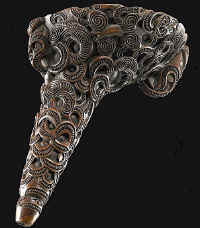
Feeding
funnel (korere) - it's not entirely certain that these funnels
were used in relation to tapu. An alternative is that they were
used following the extremely painful process of tattooing the lips.
Without its former rigidity, tapu persists to this day in certain situations, but observation is rapidly being reduced to the level of etiquette.
The belief that all sickness was caused by the sufferer's breach of tapu has long
vanished, and the Tohunga Suppression Act of 1907 was repealed in 1963. However, in certain respects
(e.g. in the case of traditional tribal burial grounds and traditionally venerated objects), observation of tapu is
common.
Utu and
mana
In utu and mana the Maori were carrying in their culture the seeds of self-destruction. No slight to one's mana (prestige) could be ignored, however trivial, and to offend one person was to affront an entire hapu.
Revenge (utu) was called for in every instance and was often exacted to a degree out of all proportion to the original insult. As a consequence
ceaseless war was central to Classic Maori life, although it was a seasonal activity restricted to times of year when the kumara plantations did not require attention.
It was essential for the tribe's mana to be preserved at all costs. For mana was derived from the gods, and without it the tribe would win no battles, could grow no crops and was doomed to perish.
This obsession with "face" has many parallels in other
cultures of oriental origin.
Cunning was as much admired as physical courage, and on countless occasions friendship would be feigned and feasts be in progress before guests would rise up to strike down their unsuspecting hosts, or vice versa. All was fair, and the unwary got only what they deserved. But common, too, were examples in set battle where food would be provided for beleaguered defenders by rival warriors anxious to determine on equal terms which side was the superior - a practice the Maori found to their surprise was not followed by the
English soldiers. Such chivalry did not extend to the treatment of prisoners, women and children, and those spared by victorious war parties might be kept as slaves only until required as food.
While the hapu who had exacted utu could feel that mana was restored, they had of necessity given rise to a grudge against themselves. Occasionally a hapu were forced by circumstance to wait generations before they were in a position to exact retribution. Wait they might, forget they would never. The fighting was endless. This state of affairs could survive while fighting was hand-to-hand and the number lost in combat relatively small. But the introduction by traders of firearms and of European concepts of conquest and kingship changed the dimension of the slaughter and made possible devastation to an unprecedented degree. While the traders enriched their Sydney bank accounts as a roaring trade developed in flax and preserved heads, the Maori decimated
one another. From perhaps 250,000 in Cook's time the Maori population had by 1854 slumped to 60,000, albeit a decline accelerated by disease and ill-health induced by changed living conditions. In 1872 novelist Anthony Trollope could fairly write: 'There is scope for poetry in their past history. There is room for philanthropy as to their present condition. But in regard to their future - there is hardly a place for hope.' By the end of the nineteenth century the Maori, then numbering barely 40,000, appeared doomed. Only the strenuous and dedicated efforts of people such as Ngata, Buck, Pomare, Heke and more recently Ratana saw the Maori as a people survive.
Maori
ownership
The earliest students of Maori society concluded that the Maori community operated a primitive form of 'communism', without any individual property rights. This is now known to be an oversimplification, for although property rights were limited they were nevertheless of importance and were zealously guarded. Everyone had
his own spears, ornaments, bird-snares and garments; in some cases ownership of standing trees was passed down from father to son. Slaves taken in battle were the absolute property of the chief who had captured them. Food was only occasionally placed in the communal storehouse as more often the whanau would keep the produce of its own labours. Even when the whole hapu embarked on a joint expedition (e.g., the building of a large eel weir or fishing with giant seine nets) the catch was divided by the chief among the whanau, the larger shares generally going to those with the hardest workers - those with the 'wet skins'.
Within the territorial boundaries of the iwi, the hapu had their own areas, and in turn parts of these were divided
among the various whanau.
Land was Papa, the Earth Mother from whom the Maori was descended, and there was no concept of land alienation other than by conquest. Even then the conquering tribe had to establish a relationship with the land by occupying it before ownership was achieved. Despite this, if in time the vanquished could return and rekindle their fires of occupation, the earlier relationship was revived and ancestral
atau re-established.
Today land titles split among large numbers of Maori owners are a legacy of communalism and such fragmentary ownership places difficulties in the path of the land's being put to good use.
Trade: The widespread use of greenstone (found only on the South Island's west coast) and of obsidian (predominantly from Mayor Island) illustrates the extent to which trading was carried on between both iwi and hapu. This grew out of the custom of
homai o homai, 'a gift for a gift'.
An iwi or a hapu on a friendly visit would take with them a variety of presents, usually chosen with a view to supplying what their hosts would most appreciate. Seaside visitors would carry fish inland, inland dwellers would supply potted birds and rats. Hapu with celebrated artisans would give articles such as carvings and garments. There was no element of barter, but custom required that in time the hospitality be reciprocated and further that the original gift be not merely matched but surpassed by the original recipients. In this way limited resources were widely spread and the practice of increasing the generosity of the gifts ensured that trade was continually expanding.
It was for visits such as these, and also to guard against possible food shortages, that the ariki would stock their large storehouses to capacity, for the handing over of gifts was followed by feasting, games and entertainments.
Maori
pa and kainga
Pa (forts), formerly spelt pah, were built on suitable ridges and in easily defended strategic positions where sea, river or swamp formed a natural barrier on at least one side. To complete the defences, trenches were dug, earth ramparts thrown up and the whole site was fenced with palisades. Inside were thatched houses built of
raupo, rua (food-storage pits) and a pahu, a wooden gong that was sounded in times of emergency to summon those living in outlying kainga.
The kainga was an unfortified village of a temporary nature and with few or no wood carvings. It was usually sited close to the kumara plantations.
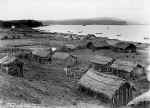 |
 |
 |
| Kawhia kainga
(1880s?) |
kainga
on the Waikato |
Ruatoki
1904 |
The word pa has come to be applied to any collection of Maori-occupied houses, generally in the vicinity of a meeting house.
Click
here for a brief glossary of Maori words
Maori
arts, crafts and customs
Maori
Meeting houses
The traditional carved
whare runanga (meeting house) is seen throughout the North Island. Built of wood, they are in the main of fairly recent origin, though they tend to perpetuate the style and symbolism of older houses on the same sites and frequently contain interior carvings of an age much greater than the houses themselves. The building of large meeting houses appears to have been a nineteenth-century development, although their central concepts reflect a continuity with earlier, if less substantial, buildings.
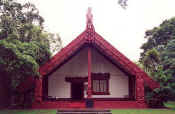
|
 |
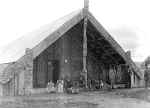 |
|
Te Whare Rununga,
at Waitangi
|
Ruatoki
runanga 1904 |
Nga Tau E Waru, at the Te Ore Ore marae near Masterton, 1897 |
The meeting house faces the marae, the focal point of the pa. It is on this open square that public gatherings are still held on matters of moment and it is traditionally regarded as the spiritual centre of the tribal unit to whom it belongs. Visitors should, where possible, ask permission locally before entering a meeting house, and should walk around a marae rather than across it.
The concept of the meeting house is symbolic of a single person, usually a tribal ancestor. His head is represented by the
koruru (mask) immediately below the tekoteko (gable figure) at the apex above the porch. The
maihi (barge-boards), usually tipped with 'fingers' (raparapa), represent his arms, the interior his belly, the lengthy ridge-pole his spine and the rafters the cages of his ribs. The individual carvings, too, are heavy with symbolism and may depict a variety of tribal ancestors, mythical figures and occasionally gods, each intimately related to the tribe. In this way the carvings served as a visual aid for the handing down of tribal history for a people with no written language.
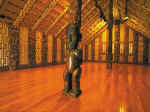
|
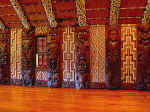 |
|
|
Interior
of the meeting house at Waitangi - carved poutokomanawa
|
Interior
of the meeting house at Waitangi - carved poupou |
|
The pare (carved lintel) over the door was of vital ritualistic importance as it served to neutralise the tapu of men who entered, usually by depicting a noa feminine subject. The fully carved interior is a comparatively recent innovation made the more feasible by the iron tools of the Pakeha which replaced the slower stone chisels of tradition. Although Cook on his first voyage noted a fully carved interior at Tolaga Bay, and in the Urewera and Arawa districts there were pre-European houses with carved figures on all
poupou (wall panels), these were then the exception rather than the rule. Between the poupou are usually tukutuku panels woven in geometric designs from flax and reeds. The
poutokomanawa (posts which support the ridge-pole) frequently depict the captains of ancestral canoes who 'welcome' those who enter. Painted patterns, frequently scrolls similar to the uncurling fern frond, embellish the rafters.
Interlocking and rhythmic, these traditional designs have modern appeal and were originally executed in black (soot mixed with shark oil), red (ochre and shark oil) and white (natural wood colour). These patterns, also used to decorate canoes, have been given symbolic names but these are open to doubt as they may have been prompted by the appearance of the designs rather than be descriptive of the motivating force behind them.
Click here for more on the meaning of Maori wood
carving.
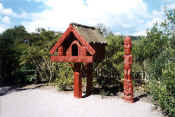
A dining hall is often close by the meeting house as traditionally it is a breach of tapu to eat in a whare runanga. However, modern meeting houses frequently include dining areas and ancillary rooms alien to the whare runanga, earning them the more appropriate description of 'community hall'.
Food was often stored in specially designated structures (pataka)
that stood on short legs possibly to keep rats away. Birds were stored,
embedded in fat, in gourd calabashes (taha). 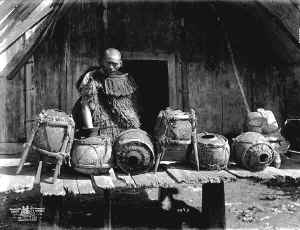
pataka - 1870
Maori
ceremony on the marae
The
marae, the area in front of the meeting house, is in
Maoritanga of much greater importance than the house itself. It is here that the Maori gathers to celebrate and to mourn, to discuss tribal or family matters, and to honour distinguished visitors.
It is when important guests are being received that the marae assumes an atmosphere of age-old ritual, yet one relevant to the present even as it perpetuates the past. The visitors (manuhiri) wait outside the marae until being called upon to enter and be welcomed (or, in the case of a funeral, to mourn).
If the guests are of high rank, the karanga is preceded by the challenge (wero), perhaps the most spectacular of all Maori ceremonies. Deriving from the need in former times to ascertain the intentions of visitors, the cry first goes up from a sentry for his people to be alert. Then, when the visitors are at the gates, he warns again, 'He taua! He taua!' ('A war party!'). A warrior then dances out towards the visitors, places an object such as a stick on the ground before them, and taunts them with war-like gestures from his
taiaha (spear). The leader of the visitors then picks up the object, indicating that they come in peace, whereupon the challenger turns his back on them and leads them onto the marae.
After the call of welcome, a powhiri (dance of welcome) may take place, followed by a pause for mourning. Even when guests have come to celebrate, respect is paid to the dead.
Welcome in speech and in song follows, and it is only after the replies to the speeches of welcome have been delivered that the gap between visitors and hosts finally closes and the first physical contact takes place - the visitors are invited to cross the marae to be greeted in person, both hand-to-hand (hariru) and nose-to-nose (hongi), and with words of welcome, 'Tena koe'.
Contrary to popular belief, the hongi does not involve a rubbing of noses but a touching, either bridge to bridge or, occasionally, first one side and then the other. Nor is it a perfunctory ritual: Samuel Marsden recounted occasions on which people would 'remain in this position for at least half an hour; during which time they sob and howl in the most doleful manner'. The hongi remains today a greeting charged with emotion, and on occasions of sorrow it still assumes a special poignancy.
The ceremony completed, informality reigns; the visitors' baggage is collected and food is served. If visitors are staying overnight they may sleep in the meeting house, bedding down communally on mattresses, wrapped in blankets and, inevitably, debating long into the night.
Maori
carving
The most common figures found in Maori carving are the human figure and the
manaia
(a bird-like, beaked figure). The most usual surface design is the spiral, used either on its own or incorporated in figures to accentuate the joints and points of movement. Secondary motifs include the
marakihau (a mermaid figure whose tubular tongue could suck up whole canoes), the
pakake (whale) and the moko (lizard). Phallic imagery abounds, symbolic of virility in war and a desire to see the tribal lineage perpetuated.
.
Theories differ as to why the Maori distorted the human figure as much as they did, though the head was probably magnified as it was the most tapu part of the body. To explain both the three-fingered hand and the slanted eyes the theory has been advanced that they are derived from a customary imposition of bird-like features on the human figure in various parts of the Pacific.
Click here for more about Maori wood carving.
Tiki is a term applied to carved human figures generally, and the significance of the well-known charm (strictly a
hei-tiki) has also been lost. The supposition that it might be a fertility charm representing the human embryo seems unlikely as early European visitors saw men as well as women wearing them, and no man of rank would have worn such a
noa object.
Click here for more about
tiki.
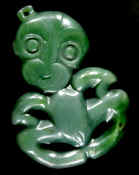
Ancestral figures are usually depicted in warlike posture, with mere (club) in hand, eyes bulging and tongue defiantly out-thrust, a gesture which also provided protection from evil forces.
The preferred wood for carving was, and still is, totara, a wood both durable yet comparatively soft.
Paua shell (Haliotus,
the abalone) is still used, as it was traditionally, to depict a figure's eyes.
Today most carvings have been painted a uniform red, a colour sacred throughout Polynesia as symbolic of mana and the power of the gods. However, traditionally only selected carvings were coloured, and then with red ochre mixed with shark oil, a substance that wore off high spots so enhancing the fine lines of the carving.
Carving was by no means confined to the meeting house. Superb examples of the carver's skill are seen in the intricate canoe prows found in museums throughout the country, and virtually every prized possession was decorated. These included treasure boxes, paddles, bailers, musical
instruments such as nose flutes, chests for burying bones, god-sticks, storehouses, gateways to pa and stockade images.
 |
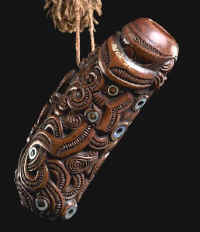 |
|
Nose
flutes - nguru
|
Two varieties of greenstone found only on the west coast of the South Island,
pounamu (nephrite - a hard jade) and tangiwai (bowenite - a translucent softer stone), were highly prized for the making of tools and
jewellery. This work was extremely time-consuming, for using traditional implements it might have taken as long as six months of full time work to fashion a single hei-tiki to perfection.
Carvers in different areas tended to have their own distinctive styles, but great carvers were often also great travellers and so their work was by no means confined to their tribal locality. Generally carving received a setback with the arrival of the missionaries, who were appalled by the carvers' uninhibited approach both to the naked form and to the sex act.
There is a tendency today to think of Maori art as stagnating after the arrival of the colonists. However, the
English metal tools made carving very much faster, and with speed came an inevitable lowering of standards.
Europeans, too, favoured the more ornate form of carving with an elaborate working of the entire surface area, and the art form may have developed to accommodate this interest. Most surviving carvings were executed with iron tools in the post-European period. Vivid examples of the development of folk art and wall paintings are
to be seen in the Rongopai meeting house near Gisborne.
With the resurgence of the Maori came renewed cultural pride, and more carved meeting houses have been erected in the past 50 years than in any other period. Maori carving differs from that of tropical Polynesia but there seems little doubt that the basic patterns would have come with the later arrivals from East Polynesia.
Maori
music
Traditional Maori songs were described by some early European voyagers as 'dreary monotones'. They included a variety of chants and a large number of
waiata (songs) both of lament (waiata tangi) and of love (waiata aroha). Waiata melodies moved within a very limited range, perhaps as little as a fourth, and the singer slid from one note to the next, an interval often less than a semi-tone. The ability to sing in this complex manner
has almost disappeared.
The familiar 'Maori' songs, such as 'Pokarekare ana' and 'Haere ra' ('Now is the hour'), date from European times. Tunes are frequently plagiarised and the 'traditional' harmonies are more or less based on the Victorian hymnal. The Maori words, however, can show great originality and in poetic terms far surpass those they displace.
Classic Maori instruments were of the flute and trumpet variety, fashioned from stone, whalebone, wood and even human bone. Drums were unknown, rhythm being supplied by foot
stamping, the slapping of both chest and thighs with the hands and occasionally the tapping of a resonant piece of wood with a stick.
The word haka, commonly applied only to the spirited Maori war dance, correctly extends to all forms of rhythmic posture dancing. Traditionally the art form derives from the marriage of
Hine-raumati (the Summer Maid) with Ra (the Sun), and their child,
Tanerore, whose appearance on warm summer days was manifest by the quivering atmosphere. It is this quivering which pervades all forms of Maori dancing, from the
peruperu (war dance) to the gentle poi dance (a dance performed only by women in which
raupo balls on the end of strings are swirled in time with music).
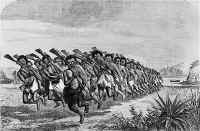
|
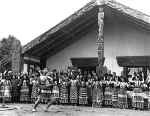
|
| Peruperu,
drawn by John Williams, probably performed to welcome Lieut. Governor Grey in 1845.
Muskets had already replaced the taiaha as the weapon of choice.
|
Haka and action song being performed at
Mahina-a-rangi meeting house, Turangawaewae marae, Ngaruawhahia. ca 1934.
The taiaha of the man lies on the ground to the left.
|
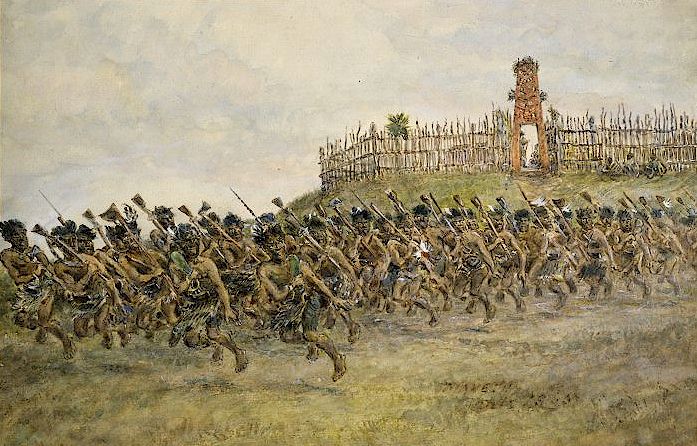
Robley's painting of a haka
performed with muskets in front of the pa at Maketu, ca.
1865.
Notice the greenstone mere held by the two haka leaders
at the front. (See below, for more on Robley.)
|
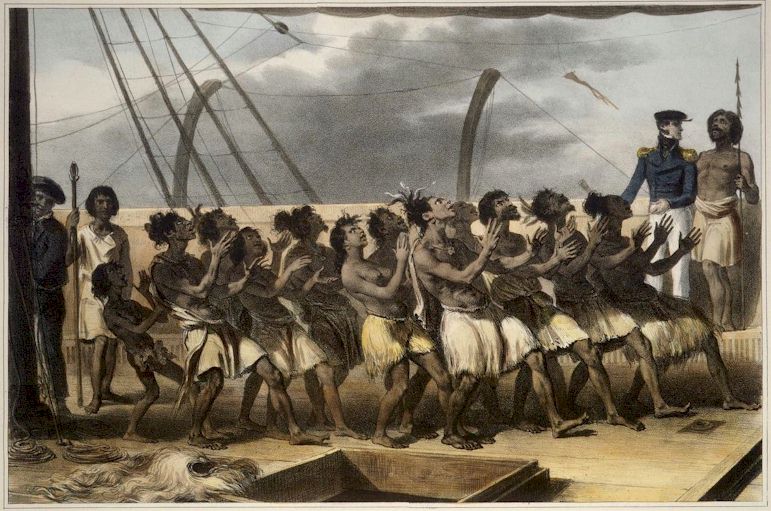
Maori performing a haka on board Dumont D'Urville's Astrolabe
at Tolaga Bay, 1827.
|
The peruperu was performed by warriors with taiaha (long clubs) in hand. Their leader held a quivering
mere (short greenstone club) and to his shouts of command the warriors would reply in chorus, stamping their feet in unison and moving their quivering hands through a series of gestures as they rolled their eyes and contorted their faces. All the while the performance was anxiously watched for omens of good or ill. Pre-eminent among haka choruses (and one often used by touring All Black rugby teams) is that associated with Te Rauparaha as he hid in a kumara pit while his enemies hunted for him. As discovery seemed certain he breathed 'Ka mate! Ka mate!' ('It is death! Death!'), and as the searchers moved away he sighed, 'Ka ora! Ka ora!' ('It is life! Life!'). When all was safe he emerged and expressed thanks to the hairy chief Te Wharerangi who had shielded him:
"Ka mate! Ka mate!
Ka ora! Ka ora!
Tenei te tangata puhuruhuru,
Nana nei i tiki meiI whakawhiti re ra!
Upane! Upane!
Upane! Kaupane!
Whiti te ra!''
"It is death! It is death!
It is life! It is life!
This is the hairy person
Who caused the sun to shine!
One upward step! Another upward step!
One last upward step! The step forth!
Into the sun that shines!"
The peruperu has been adopted by a number of schools and some sporting groups, and is occasionally performed at school rugby matches.
Maori
Weapons
The Maori stone-age culture was based first on obsidian and later, from about 1,000 years ago, on greenstone
(pounamu and tangiwai). The shift in emphasis came when quantities of these fine-grained rocks were found on the South Island's west coast.
In the Archaic Maori period, warfare seems to have been unknown. The population was small and food was plentiful. But the later Polynesian arrivals brought with them the short club (patu) made of wood, bone or stone, and the long-handled club, the
taiaha and
tewhatewha. Most highly prized of all, and cherished for generations, was the
mere, a
patu pounamu (greenstone club). So fabled was the occasional individual mere that a prisoner-of-war might actually ask to be killed by it - a request granted only if the prisoner were considered worthy of the
honour.
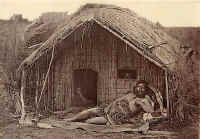
Te
Rangi Tahau of Waipahihi, Lake Taupo, lounging in the porch of his whare.
He displays the patu he used to kill many prisoners taken in
battle and wears a tiki (mid 1870s)
Maori
moko and tattoo
In the 1950s, there were a very few elderly Maori women with
authentic moko, tattooed lips and
chin, still to be seen sitting in the sun near the ferry wharf in my home
town of Tauranga, but the authentic Maori art of tattooing (moko) has long since
vanished. Recently, something superficially similar has made an
appearance among men, but it is no more than a variant of
the current international tattoo and body-piercing fashion craze. Anyone
who believes otherwise is as silly as a two-bob watch.
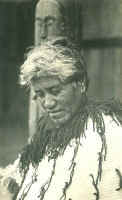
Traditional
moko, occasionally seen until the 1950's.
In Classic Maori society the male was liberally embellished, the fully tattooed flourishing decorated cheeks, chin, nose and forehead as well as buttocks and thighs. Tattooing was a sign of status and far from simply decorating the face, the Maori of rank did not acquire his 'real' face until he had been tattooed. Indeed, personal tattoo patterns were often remembered rather than facial characteristics.
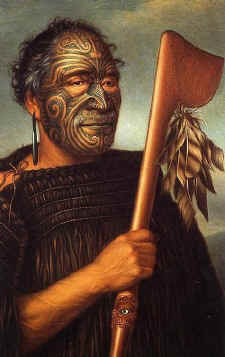
Tamati
Wakanene
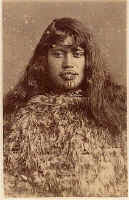
|
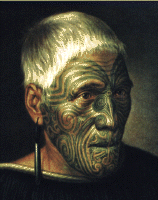
|
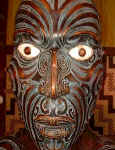
|
Maori wahine with chin
and lip moko, wearing a feather awarua
|
Maori
kaumatu with full
face tattoo, the mana that comes with age brilliantly
captured.
|
Carved
figure with full
face tattoo
|
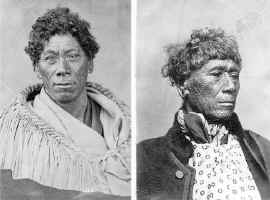
|
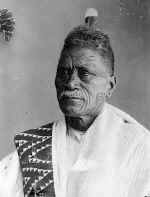
|
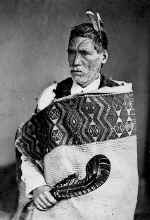
|
| Full
face tattoos, about 1869
|
Tukaroto Potatau Matutaera Tawhiao
1880s
|
Rewi
Manga Maniapoto
|
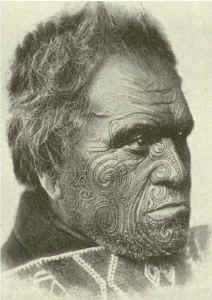 |
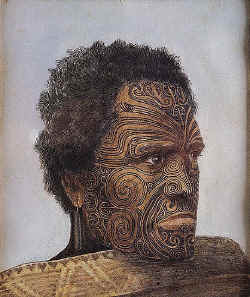
|
|
Tomika
Te Mutu,
1866,
a chief of rank of the Ngaiterangi, living on Motuhoa Island in Tauranga harbour
(not, as is sometimes reported, Whale Island (Motuhora) off
Whakatane). Left as photographed and Right as painted
from the photo by Major-General Sir Horatio Gordon Robley
(Te Ropere. 1840 - 1930). For artistic purposes, Te Mutu's kaitaka is depicted
upside down with the lower hem showing at the top.
From: ROBLEY, Major-General: Moko or Maori Tattooing (London, Chapman and Hall, 1896)
Robely had an intense interest in moko, boundless energy and
considerable skill in sketching and water colours, as well as
considerable acumen in buying mummified heads (mokomokai).
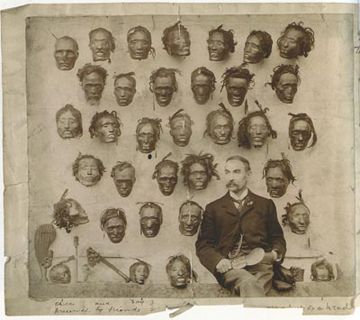
Much of what we know of ancestral Maori tattoo and
tattoo tradition comes from the studies and documentation
assembled by Robley. Robley was an accomplished linguist (he
spoke Burmese, for example) who spoke excellent Maori (Te Reo).
He was well-known to Maori elders throughout the Bay of Plenty,
and used his artistic skills to illustrate and paint scenes of the Maori way of life.
The National Museum in Wellington houses seventy of his paintings.
He had a son with his companion Herete Mauao, named Hamiora Tu Ropere.
His son, Hamiora Tu, married Te Pokohino and they had two children, a son, Hepeta Hamiora Tu and a daughter, Te Hepiwhara Hamiora Tu.
Robley was well-known for his collection of mokomokai, eventually
numbering 35 examples. In 1908 he offered them to the New Zealand Government for £1,000 but his offer was
turned down.
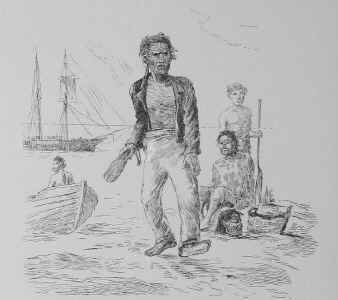
A
sketch by Robley of a chief bargaining over the selling price of
the head sitting on the beach.
|
|
After death the mummified heads of one's own tribe were affectionately preserved and the heads of chiefs of other tribes were similarly kept, but as objects to be both insulted and humiliated.
Pakipaki (preserved, not shrunken, heads) are occasionally seen in museums and for a time in the early 1800s they were keenly sought after by traders as curios which commanded high prices in Europe.
Tattooing was a painful process, conducted with uhi (serrated chisel) and mallet, soot being rubbed into the open wound to provide colouring. The Maori
technique differed from other Polynesian tattooing in that designs were actually cut and not just pricked into the flesh.
Maori
Rock drawings
Drawings on rocks are found in various parts of the North Island but more particularly in the South Canterbury and North Otago regions of the
South Island. These are either painted with red ochre or scratched out with sharp stones. There is no certain way of dating these drawings but the appearance of huts and ships in some makes it plain that some at least post-date the arrival of
Englishmen. Subjects vary, but birds, canoes and mythical figures are
common.
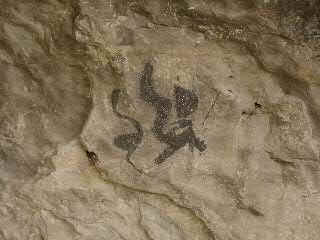
|

































